Sap feeders
Citrus aphids
Black aphid: Toxoptera aurantii,
Brown aphid: Toxoptera citricida
| Symptoms of damage |
- Feed on tender foliage and flowers.
- Transmit tristeza virus disease.
- Nymphs and adults suck the sap of leaves
- Wilting and flower dropping
- Infested leaves - cup shaped and crinkled
- Growth of the plants is hindered.
|
 |
| Crinkling of leaves |
|
| Identification of pest |
 |
 |
| Adult wingless forms (apterae) |
Adult winged forms (alatae) |
|
Citrus Black fly, Aleurocanthus woglumi
| Symptoms of damage |
- The cell sap is sucked from the leaves - piercing stylet
- Leaf curling.
- Leaves fall off immaturely.
- Honey dew secrecation development of sooty mould fungus.
- Leaf turns to black in colour and affects photosynthetic activity of the leaves.
- Affected trees produce - few blossoms which develop into inspid fruits.
|
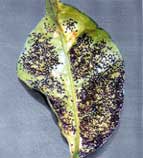 |
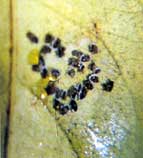 |
| Black flies on leaf |
Close-up of Black flies |
|
| Identification of pest |
-
Nymphs - are flattened, oval in shape and scale like in appearance.
-
Adult - minute insect, shiny black with grey dusting on the body.
-
Wings are extending beyond the tip of the abdomen.
|
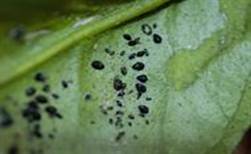 |
| Black fly on leaves |
|
| Management |
-
Collect and destroy the damaged plant parts along with nymphs, pupa and adults
-
Spray with 2 ml of chloropyriphos per litre of water
-
Ffemale lays eggs on lower surface of leaves in a form of three (15-22 eggs/whorl) whorls
-
The entire plant canopy should be drenched with the solution.
-
Encourage activity of parasitoids, Encarsia sp., Eretomocerus serius and chlysoperla sp.
|
Citrus psyllid, Diaphorina citri
| Symptoms of damage |
-
Both nymphs and adults suck sap from the plants and injection of toxic saliva.
-
Nymphs - are more destructive, crowd on the terminal shoots, buds and tender leaves
-
Excrete honeydew - growth of sooty moulds.
-
Affected plant parts dry and die away
-
It is transmits the "Greening" virus
|
 |
 |
| Psyllid infested plants |
Sooty mould on leaves |
|
| Identification of pest |
|
-
Nymphs - are flattened, oval in shape and scale like in appearance.
-
Adult - minute insect, shiny black with grey dusting on the body.
-
Wings are extending beyond the tip of the abdomen.
|
| Management |
- Collect and destroy the damaged plant parts
- Spraying with systemic insecticides at flush growth periods
- Encourage the activities natural enemies such as Syrphids and Chrysopids
|
Mealy bug, Planoccus citri
| Symptoms of damage |
-
Large amounts of honey dew excrete - sooty mould fungus.
-
Fungus covers the foliage and fruits
-
In severe infestation the flowers do not form fruits.
|
 |
| Mealy bug on fruits |
|
| Identification of pest |
-
Eggs – are laid in clusters, protective cottony mass
-
Nymphs – are amber coloured with white waxy coating with filaments
-
Adult - Male is winged, long antenna and without mouth parts.
-
Female is wingless, flat body and short, waxy filaments along the margins
|
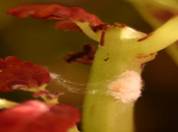 |
 |
| Egg mass |
Adult female and crawlers |
|
| Management |
- Collect and destroy the damaged leaves, twigs and stems
- Debark branches and apply methyl parathion paste
- Use sticky trap (5cm length) on fruit bearing shoots
- Spray dichlorvas 0.2% in combination with fish oil rosin soap 25g/lit
- Single soil application of aldicarb 10G at 50g/tree at the time of pruning
- Soil treatment with chlorophyriphos apply on the near the tree trunk
- Spraying of trees with acephate, methomyl, or chlorpyriphos.
- Field release of Australian lady bird beetle Cryptoleamus montrouizeri 10 per tree
|
Fruit sucking moth, Otheris materna, O. ancilla, O. fullonica
| Symptoms of damage |
- Adult pierce the fruit and suck the juice
- Rottening at the feeding site
- Fruit dropping
|
 |
| Affected fruit |
|
| Identification of pest |
|
- Larva – orange blue and yellow spots on velvety dark speckled on the body
- Adult – stout moth and orange coloured wing
- Otheris materna – three black spots on the fore wing
|
| Management |
- Destroy the weed host Tinospora cardifolia and coccules pendules
- Bag the fruit with polythene bag (500 gauge)
- Apply smoke to prevent adult moth
- Trap crop – growing tomato crop in orchards to attract the adult moth
- Poison bait
- dilute suspension of fermented molasses and malathion 0.05% (50 EC at 1ml/lit)
- Use light trap or food lure to attract moths
|
Citrus thrips, Thrips nilgiriensis
| Symptoms of damage |
 |
 |
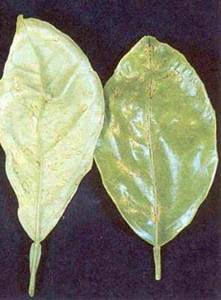 |
| Scarring on Fruit |
Shoot damage |
Leaf damage |
|
- Nymphs and adults lacerate the leaf tissue and suck the sap from fruits
- Leaf curling
- Ring like appearance on the fruit
- Irregular mottled patches on rind
|
| Identification of pest |
- Adult – yellowish, fringed wing
|
 |
| Egg mass |
|
| Management |
- Collect and destroy the damaged plant parts
- Spraying with systemic insecticides at flush growth periods
- Encourage the activities natural enemies such as Syrphids and Chrysopid
|
Cottony cushion scale, Icerya purchasi
| Symptoms of damage |
- Nymphs and adults suck the sap from leaves
- Honey dew excretion
- Development of sooty mould fungus
|
| Identification of pest |
-
White, ribbed masses that hold up to 800 red eggs.
-
Nymphs are red with black legs and antennae.
-
Adults are covered in white hair.
|
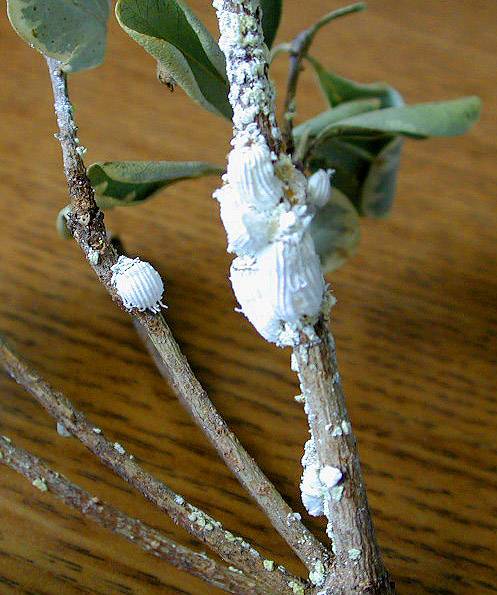 |
 |
| Cottony cushion scale, Icerya purchasi |
|
| Management |
-
Spray dormant oil in late winter before spring.
-
Spray horticultural oil, if needed, year round.
-
Apply mixture of manure compost tea, molasses, citrus oil.
-
Garlic-pepper tea also helps.
-
Natural predators usually keep this insect in check.
-
Control ants and dust which can give the scale a competitive advantage.
-
Field release of vedalia and Australian ladybugs.
|
Leaf feeder
Citrus leaf miner, Phyllocnistic citrella
| Symptoms of damage |
-
Caterpillars are attacked tender leaves and feed on the epidermis
-
Making silvery appearance presence on the lower surface of leaves
-
Leaves – distorted and crinkled
-
Severe attack caused defoliation
-
Encourage the incidence of citrus canker
|
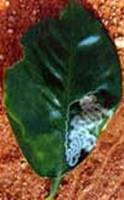 |
 |
| Serpentine larva |
Crinkled leaves |
|
| Identification of pest |
- Eggs – are minute, flattened presence on the lower side of the midrib
- Larvae – minute, yellowish or reddish and apodous.
- Settled down on the edge of the folded leaves
- Adult – minute moth, black spot at the tip of the fore wing
|
Citrus butterfly , Papilio demolious, P. Polytes, P.helenus
| Symptoms of damage |
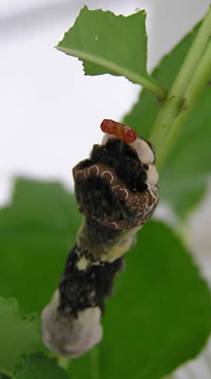 |
 |
| Defoliation |
Larva feeding |
|
- Caterpillars prefers on light green tender leaves
- Feeding voraciously and leaving only the mid-ribs
- Severe infestation the entire tree gets defoliated.
|
| Identification of pest |
- Early stage larva resembles bird dropping
- Grown up larva – cylindrical, stout, green and brown lateral bond
- Adult
|
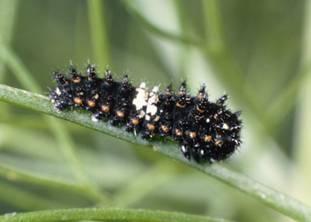
|
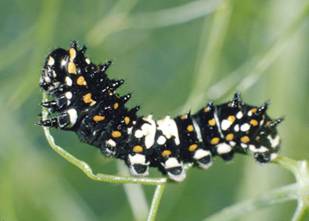
|
First instar |
Second instar |

|
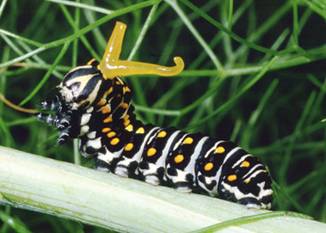
|
Third instar |
Fourth instar with osmotoria |
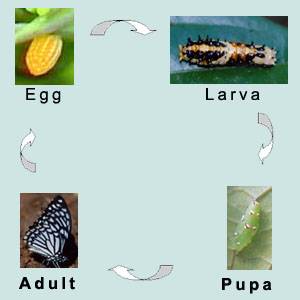 |
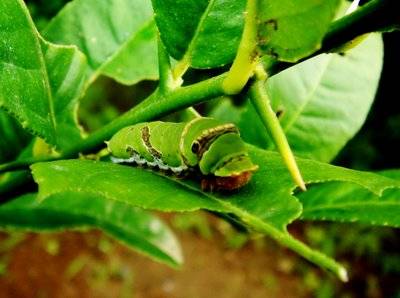 |
Life cycle |
Grown up larva |
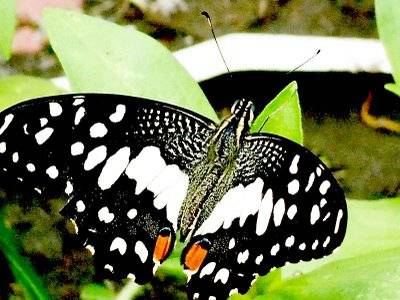 |
 |
Papilio demolious |
Papilio polytes |
| Management |
- Hand pick the larvae and destroy
- Field release of parasitoids Trichogramme evanescens and Telenomus sp on eggs
- Brachymeria sp on larvae and Pterolus sp. on pupae.
|
|

